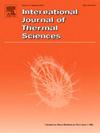Theoretical study on showerhead film cooling effectiveness of adjustable guide vane installation angle for variable cycle Aeroengine
IF 4.9
2区 工程技术
Q1 ENGINEERING, MECHANICAL
International Journal of Thermal Sciences
Pub Date : 2025-02-11
DOI:10.1016/j.ijthermalsci.2025.109786
引用次数: 0
Abstract
As a critical component of variable cycle engine, the adjustable turbine guide vane adapts to the aero-engine flow requirements by varying its installation angle (θ). However, research on film cooling techniques for adjustable turbine guide vanes is still insufficient. In this study, we conducted an investigation into showerhead film cooling, measuring its cooling efficiency using pressure-sensitive paint, and analyzing its flow characteristics through numerical simulations. Furthermore, three improved cooling schemes for showerhead cooling of adjustable turbine guide vane were proposed and compared for their enhancement effects. The results indicate that a decrease in installation angle leads to a shift of the stagnation line on the leading edge towards the pressure side and a reduction in the passage area, resulting in an increase in the pressure coefficients on both the suction and pressure sides. At the same time, installation angle significantly affects the coolant distribution in the leading edge film holes. A decrease in installation angle increases the coolant flow rate on the suction side of the leading edge, thus increasing the non-uniformity of coolant distribution. However, increasing the Mass flow ratio can mitigate this effect. Among the three proposed improved cooling schemes, it was found that reducing the hole inclination angle and changing the film hole layout significantly improved the film cooling effectiveness and the consistency of the cooling effect. The cooling scheme that adjusted the hole inclination angle resulted in a maximum increase of 62.5 % in film cooling effectiveness (η), while the cooling scheme that modified the hole layout reduced maximum variation in film cooling effectiveness (Δηmax) by 43.9 %.
求助全文
约1分钟内获得全文
求助全文
来源期刊

International Journal of Thermal Sciences
工程技术-工程:机械
CiteScore
8.10
自引率
11.10%
发文量
531
审稿时长
55 days
期刊介绍:
The International Journal of Thermal Sciences is a journal devoted to the publication of fundamental studies on the physics of transfer processes in general, with an emphasis on thermal aspects and also applied research on various processes, energy systems and the environment. Articles are published in English and French, and are subject to peer review.
The fundamental subjects considered within the scope of the journal are:
* Heat and relevant mass transfer at all scales (nano, micro and macro) and in all types of material (heterogeneous, composites, biological,...) and fluid flow
* Forced, natural or mixed convection in reactive or non-reactive media
* Single or multi–phase fluid flow with or without phase change
* Near–and far–field radiative heat transfer
* Combined modes of heat transfer in complex systems (for example, plasmas, biological, geological,...)
* Multiscale modelling
The applied research topics include:
* Heat exchangers, heat pipes, cooling processes
* Transport phenomena taking place in industrial processes (chemical, food and agricultural, metallurgical, space and aeronautical, automobile industries)
* Nano–and micro–technology for energy, space, biosystems and devices
* Heat transport analysis in advanced systems
* Impact of energy–related processes on environment, and emerging energy systems
The study of thermophysical properties of materials and fluids, thermal measurement techniques, inverse methods, and the developments of experimental methods are within the scope of the International Journal of Thermal Sciences which also covers the modelling, and numerical methods applied to thermal transfer.
 求助内容:
求助内容: 应助结果提醒方式:
应助结果提醒方式:


